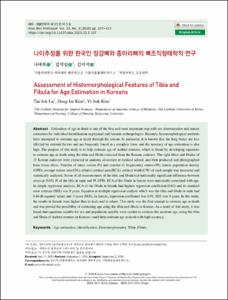나이추정을 위한 한국인 정강뼈와 종아리뼈의 뼈조직형태학적 연구
- Keimyung Author(s)
- Kim, Deog Im
- Department
- Dept. of Nursing (간호학)
- Journal Title
- 해부·생물인류학
- Issued Date
- 2020
- Volume
- 33
- Issue
- 3
- Keyword
- 나이추정; 신원확인; 조직형태학; 정강뼈; 종아리뼈; Age estimation; Identification; Histomorphometry; Tibia; Fibula
- Abstract
- Estimation of age at death is one of the first and most important step with sex determination and stature estimation for individual identification in physical and forensic anthropologies. Recently, histomorphological methods have attempted to estimate age at death through the osteon. In particular, it is known that the long bones are less affected by external factors and are frequently found in a complete form, and the accuracy of age estimation is also high. The purpose of this study is to help estimate age of skeletal remains, which is found by developing equations to estimate age at death using the tibia and fibula extracted from the Korean cadavers. The right tibias and fibulas of 31 Korean cadavers were extracted in anatomy dissection at medical school, and then produced and photographed bone tissue slices. Number of intact osteon (Pi) and number of fragmentary osteon (Pf), osteon population density (OPD), average osteon area (OA), relative cortical area (RCA), cortical width (CW) of each sample was measured and statistically analyzed. Seven of all measurements of the tibia and fibula had statistically significant difference between sexes (p<0.05). Pi of the tibia in male and Pf, OPD, RCA of the fibula in female were statistically correlated with age. In simple regression analysis, RCA of the fibula in female had highest regression coefficient (0.62) and its standard error estimate (SEE) was 8 years. Equation at multiple regression analysis which was the tibia and fibula in male had 0.44 (R-squared value) and 11years (SEE). In female, regression coefficient was 0.91, SEE was 6 years. In this study, the results in female were higher than in male and in others. This study was the first attempt to estimate age at death and was proved the possibility of estimating age using the tibia and fibula in Korean. As a result of this study, it was found that equations suitable for sex and population-specific were needed to estimate the accurate age, using the tibia and fibula of skeletal remains in Koreans could help estimate age at death with high accuracy.
사망 당시 나이추정은 체질인류학과 법의인류학분야에서 성별판별, 키추정과 함께 신원확인을 위한 중요한 요소 중 하나이다. 최근 사망 당시 나이를 추정하는 방법 중 뼈단위를 이용한 조직형태학적 방법이 많이 사용되고 있으며 사람의 뼈 중 긴뼈는 외부요인에 영향을 적게 받고 온전한 형태로 발견되는 빈도가 높으며 나이추정의 정확도도 높다고 알려져 있다. 이 연구의 목적은 한국인 시신에서 추출한 종아리의 뼈를 이용하여 사망 당시 나이를 추정할 수 있는 방정식을 만들어 발견되는 백골화시신의 사망 당시 나이추정에 도움을 주는 것에 있다. 의과대학 해부학실습에 사용된 31구의 시신에서 오른쪽 정강뼈와 종아리뼈를 추출하여 뼈조직슬라이스를 생성하고 촬영하였다. 정강뼈와 종아리뼈 각각의 뼈조직슬라이스에서 뼈단위개수 (Pi), 조각뼈단위개수 (Pf), 단위뼈단위밀도 (OPD), 평균뼈단위면적 (OA), 상대적겉질비율 (RCA), 겉질길이 (CW)를 계측하고 통계분석하였다. 정강뼈와 종아리뼈의 모든 계측항목 중 7개는 성별에 따라 통계학적으로 유의한 차이가 있었다 (p<0.05). 남자는 정강뼈의 Pi가, 여자는 종아리뼈의 Pf, OPD, RCA가 나이와 통계학적으로 유의한 상관관계가 있었다. 단순회귀분석결과 여자 종아리뼈의 RCA 항목이 회귀계수 (0.62)가 가장 높았으며 표준추정오차는 8년이었다. 다중회귀분석에서 남자의 정강뼈와 종아리뼈를 함께 사용한 방정식은 회귀계수 0.449, 표준추정오차 11년이었고, 여자의 방정식에서 회귀계수는 0.91, 표준추정오차 6년이었다. 이 연구에서 여자의 결과값은 남자보다, 다른 연구들의 결과값보다 회귀계수가 높았으며 표준추정오차 범위도 작았다. 이 연구는 한국인 정강뼈와 종아리뼈를 이용한 사망 당시 나이추정의 첫 시도이며 정강뼈와 종아리뼈를 이용한 나이추정 가능성을 확인하였다. 이 연구의 결과로 정확한 나이를 추정하기 위해서는 성별과 인구집단에 맞는 방정식이 필요하다는 것을 알 수 있었으며 한국인 백골화시신에서 정강뼈와 종아리뼈를 이용하면 정확도가 높은 사망 당시 나이를 추정할 수 있을 것이다.
- Alternative Title
- Assessment of Histomorphological Features of Tibia and Fibula for Age Estimation in Koreans
- Keimyung Author(s)(Kor)
- 김덕임
- Publisher
- College of Nursing (간호대학)
- Citation
- Tae-lok La et al. (2020). 나이추정을 위한 한국인 정강뼈와 종아리뼈의 뼈조직형태학적 연구. 해부·생물인류학, 33(3), 107–115. doi: 10.11637/aba.2020.33.3.107
- Type
- Article
- ISSN
- 2671-566X
- Source
- https://e-aba.org/DOIx.php?id=10.11637/aba.2020.33.3.107
- Appears in Collections:
- 2. College of Nursing (간호대학) > Dept. of Nursing (간호학)
- 파일 목록
-
-
Download
 oak-2020-0726.pdf
기타 데이터 / 525.76 kB / Adobe PDF
oak-2020-0726.pdf
기타 데이터 / 525.76 kB / Adobe PDF
-
Items in Repository are protected by copyright, with all rights reserved, unless otherwise indicated.